The Samsung Galaxy S7 and S7 edge Review: Part 2
by Joshua Ho on July 5, 2016 8:00 AM ESTSystem Performance Revisited
Now that we’ve covered battery life we can revisit another topic where our testing has changed dramatically for 2016, which is our system performance benchmarks. As previously mentioned this year a major goal of ours was to focus on benchmarks with metrics that better indicate user experience rather than being subject to additional layers of indirection in addition to updating our previously used benchmarks. Probably one of the hardest problems to tackle from a testing perspective is capturing what it means to have a smooth and fast phone, and with the right benchmarks you can actually start to test for these things in a meaningful way instead of just relying on a reviewer’s word. In addition to new benchmarks, we’ve attempted to update existing types of benchmarks with tests that are more realistic and more useful rather than simple microbenchmarks that can be easily optimized against without any meaningful user experience improvements. As the Galaxy S7 edge is identical in performance to the Galaxy S7, scores for the Galaxy S7 edge are excluded for clarity.
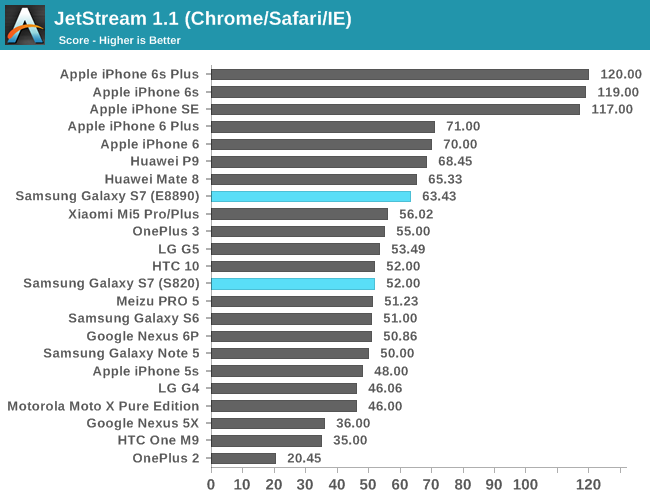
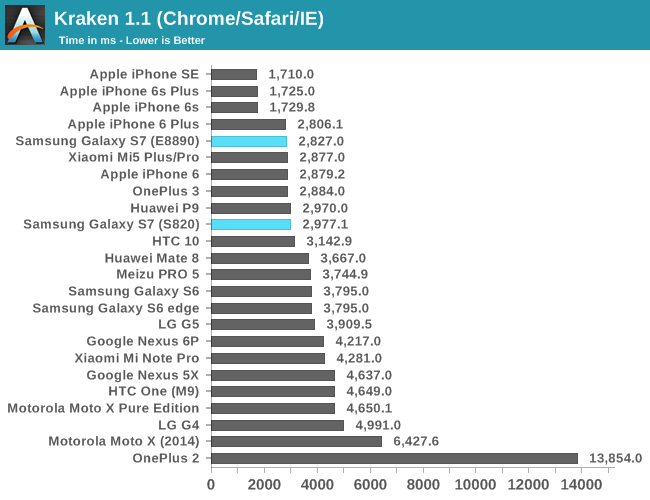

In browser/JavaScript performance the Galaxy S7 in its Snapdragon 820 variants performs pretty much as you'd expect with fairly respectable performance about on par with the iPhone 6 at least part of the time, which frankly still isn't enough but a lot of this is more due to Google's lack of optimization in Chrome than anything else. The Exynos 8890 version comes a lot closer but it still isn't great. Subjectively browsing performance on the Galaxy S7 with the Snapdragon 820 is still painful with Chrome, and I have to install either a variant of Snapdragon Browser or Samsung's stock browser in order to get remotely acceptable performance. Even then, performance isn't great when compared to Apple's A9-equipped devices. The lack of single thread performance relative to other devices on the market in conjunction with poor software optimization on the part of Google is really what continues to hold OEMs back here rather than anything that Samsung Mobile is capable of resolving.
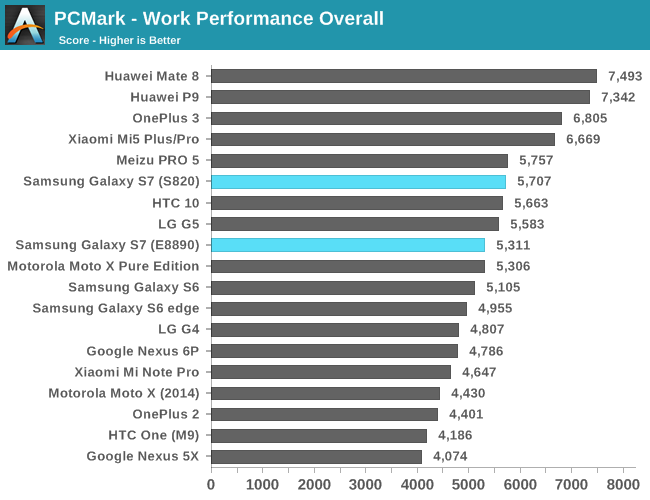
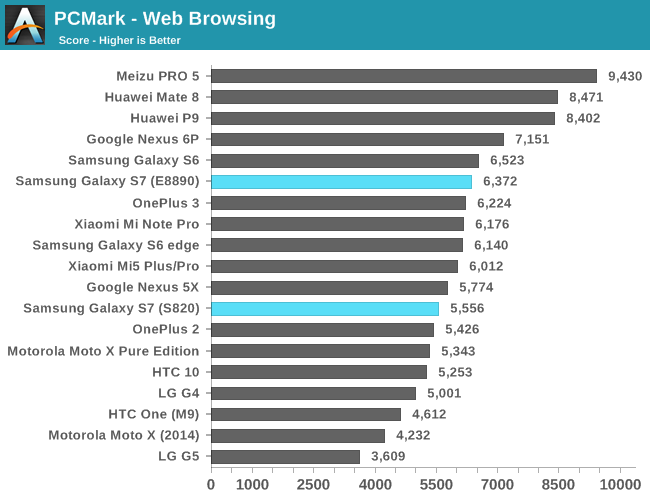
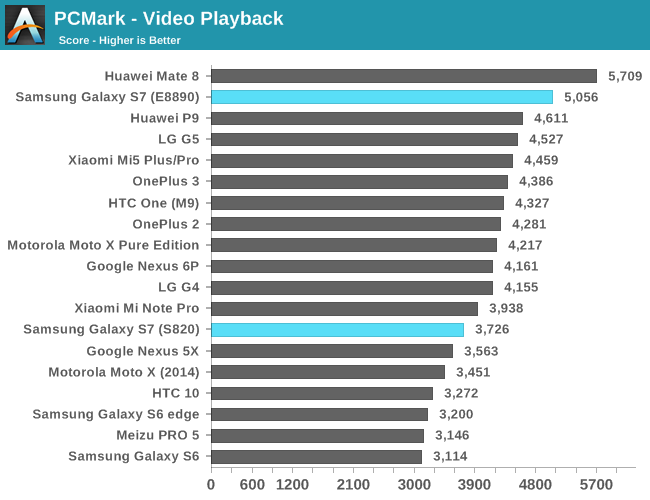
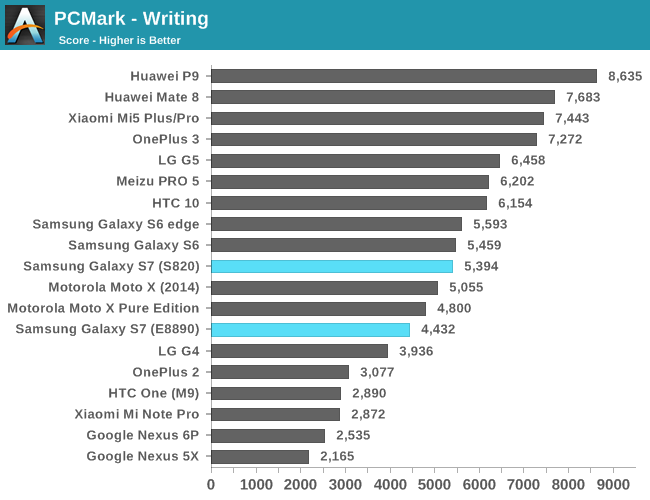
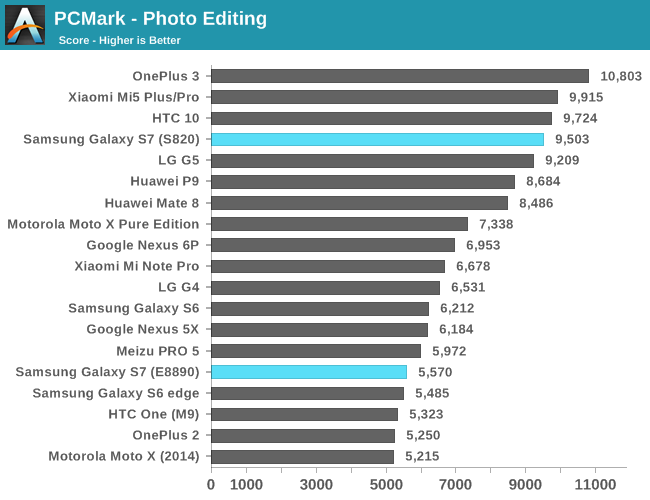
PCMark shows that the Galaxy S7 is generally well-optimized, with good performance in native Android APIs, although devices like the OnePlus 3 pull ahead in general, likely due to differences in DVFS, lower display resolution, more RAM, and similar changes as the hardware is otherwise quite similar. In general though unless you get something with a Kirin 95x in it you aren't going to get performance much better than what you find in the Galaxy S7, although the software optimization in cases like the writing test could be better for the Snapdragon 820 version of the phone.
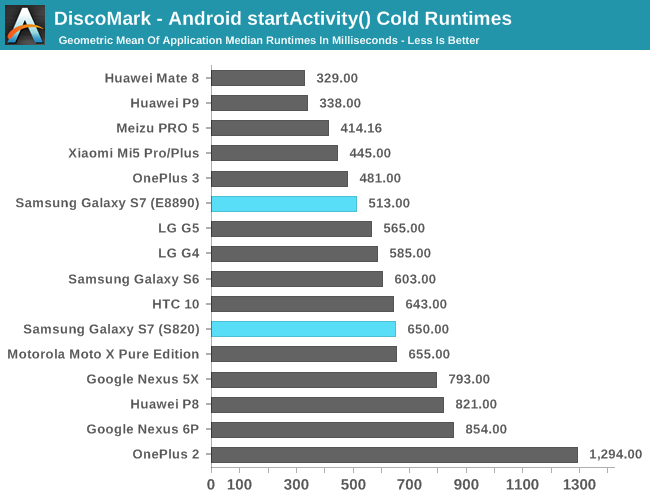
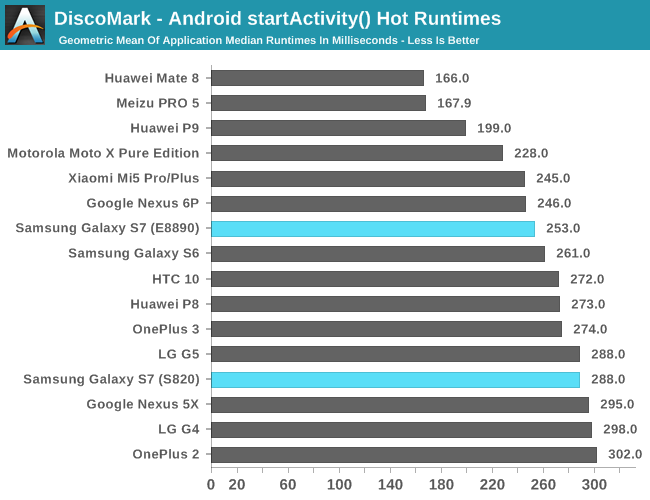
As hinted by the PCMark results, the Galaxy S7 with the Snapdragon 820 is really nothing to write home about when it comes to actual software optimizations, while the Exynos 8890 version is significantly faster in comparison. The fastest devices by far here are still the Kirin 950-equipped phones, but even from cold start launches the HTC 10 is comparable, and pulls ahead slightly when the applications are pre-loaded into memory. The OnePlus 3 and Xiaomi Mi5 are closer to what the S820 GS7 should be achieving, which is really more a testament to just how strangely slow the Galaxy S7 with Snapdragon 820 is.
Overall though, the Galaxy S7 in both iterations are acceptably fast for general purpose tasks. However, with that said the Snapdragon 820 variant is noticeably slower, and the software stack seems to be less optimized for whatever reason even after multiple post-launch OTAs and all the latest app updates. Given that these devices have locked bootloaders it's difficult to really go deep and try to figure out exactly what's causing these issues, but it's likely that Samsung Mobile has the engineering staff to do this and resolve these issues as a 600 USD phone really shouldn't be performing worse than a 400 USD phone. On the bright side, the Exynos 8890 variants perform quite well here, with performance comparable to top devices and often beating out Snapdragon 820 devices, although usually not by a huge margin.


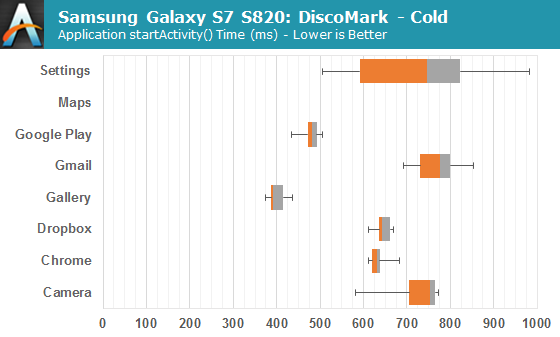
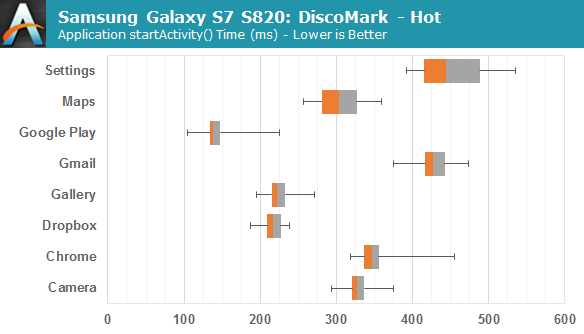








266 Comments
View All Comments
The Garden Variety - Tuesday, July 5, 2016 - link
From now on, Anandtech should first conduct a comprehensive survey of people's anecdotal experiences with a given product, and compare those anecdotes against their completed (but unpublished) review. Any instance where the anecdotes disagree with the un-published findings, those un-published findings should immediately be removed, or changed to reflect agreement with the consensus of anecdotes. Any refusal to do so, or immediately acknowledge the veracity of those anecdotes is a sign of bias, and the likelihood that great sums of money are changing hands behind the scenes becomes self-evident.There's no place for technology reviews that do not reflect consensus. None. To believe otherwise means you are part of the conspiracy and your opinions on all subjects are invalid.
MonkeyPaw - Tuesday, July 5, 2016 - link
I see what you're saying, but sometimes you have to question testing methodology. In my case, the LG G4 scores lower battery on wifi versus LTE. That goes against my personal experience, but it also goes against the long-standing expected results. By nature, wifi shoukd be better, as the phone is closer to source and disables mobile data to boot. Pointing this out should hopefully provide insight to AT.whiteiphoneproblems - Tuesday, July 5, 2016 - link
Haha -- um, I'm almost certain TGV is being sarcastic (as in their other great comments here).name99 - Tuesday, July 5, 2016 - link
Where's the usual comment complaining about one month and still no GTX 1080 review?Someone is slipping up!!!
Michael Bay - Wednesday, July 6, 2016 - link
I don`t see you shilling for crapple either!vyis - Tuesday, July 5, 2016 - link
I feel that this new review is a degradation compare to previous method.First of all, why do a in-lab like battery life measurement while disabling all the background services? There's a fare share of background service that should be left running to show differences in manufacturer control of background service (and samsung is particular bad at this)
On the GPU side, it's not an accurate statement for say SD820 won't do as well in game as A9. It depends on Game API and GPU design bias on type of raw processing core. On android, game developer may not code to harness the full potential of SD820 processing power. Apple did have upper hand as they straight down hardware to software control.
There's a mistake at camera section. "There is nothing out there that can realistically match the dual pixel AF system in the Galaxy S7, especially once you get into low light scenarios where traditional PDAF systems are overwhelmed by noise" Instead of PDAF, it should be contrast detection AutoFocus that struggle in low light.
For daylight still, samsung do have more sharping processing, however, 6s plus is not light on post-processing. In good lighting condition, 6s plus process away too much details. Without raw file i can't be sure type of processing being done. More over, s7 lens element is of sharper focus compare to 6s plus.
For low light still, i'm interested in all the 6s s7 comparison mention all over the article, just click into original file and see for yourself. For s6 and s7 comparison, it's hard to say without raw file. A different direction of post processing is being used.
Regardless, i can't agree that samsung have gone the direction of stronger noise reduction and sharpening. I can obviously see a much stronger noise reduction used on s6 low light still.
Video wise no comment. Sony digital image stabilization is best implementation on smartphone. Those tiny OIS on smartphone just making viewer sea sick.
Battery life, i do agree s7 is just ok. Sammy software have a problem in control background activity.
Impulses - Thursday, July 7, 2016 - link
Dunno whether you can really make any generalisation regarding PDAF vs CDAF in low light... If you go look at high end cameras, the best DSLR out there tend to AF pretty great in low light but not necessarily across the whole frame and not all high end DSLR are equally adept at it.Then you look at mirrorless bodies which traditionally rely on CDAF more heavily and there's a lot of them (even with smaller sensors like Panasic/Olympus) that can absolutely nail low light AF regardless.
Most of the mirrorless bodies are going with a hybrid approach anyway (largely for C-AF purposes, which falls well beyond what any phone is capable of), so yeah, I dunno... Seems like a pointless generalisation.
On a technical level Samsung's dual pixel AF seems pretty interesting, it's odd that it never saw the light of day in their larger sensors and NX system before they killed it off.
joex4444 - Tuesday, July 5, 2016 - link
Huawei, Xiaomi, and OnePlus are priced the way they are because they have next to no brand recognition. If they can start to prove a track record of quality phones that have demand, I would expect them to start selling for $600-$800 not $400.UtilityMax - Tuesday, July 5, 2016 - link
If Oneplus, like a decade later, finally earns a widespread brand recognition so it can charge some premium prices for its products, then some other startup manufacturer will take their place. In fact, sooner or later we're going to see a collapse of the prices of the big brand smartphones. We have already reached a "peak iPhone" in the sense that a LOT of people who are owning a three year old flagship smartphone will no longer be compelled to shell out 600-800 bucks for this years latest model. 200-300USD is already new normal for the mid-range smartphones. I just saw a brand new Moto G4 test phone at Best Buy, and that's how they're priced already.fanofanand - Wednesday, July 6, 2016 - link
This right here. Commoditization is taking place like in the PC space, and while there may be a few remaining "high-end" phones out there, the VAST majority of sales will come in the sub $400 space. With subsidies disappearing, fewer and fewer people will shell out $700-1000 for a new phone every year, or even every other year. Just taking a look at the mid-range phones in the $200-300 space, as you mentioned, yields a huge number of competent phones that will meet the majority of users needs. Apple is going to need a new trick to maintain it's profitability, which is probably why they are flinging things at the wall in desperation, i.e. the watch, the Apple Car, etc.